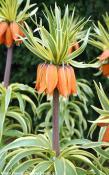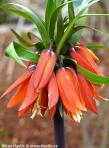Fritillaria imperialis 'WILLIAM REX'

Fritillaria imperialis 'WILLIAM REX'
crown imperial
crown imperial
| SIZE/TYPE | mid-sized perennial |
|---|---|
| USUAL HEIGHT | 0.6-0.8m |
| USUAL WIDTH | |
| LEAVES | deciduous broadleaf |
| COLOUR OF LEAVES |
 green green |
| FLOWERS | showy |
| COLOUR OF FLOWERS |
 + + multicolored:orange and red multicolored:orange and red
|
| BLOOMING TIME | April - May |
| LOCATION | full sun |
| USDA zone (lowest) | 5b (down to -27°C) |
| WINTER PROTECTION | |
| FOR ZONE 5+6 |

|
| FOR ZONE 7 |

|
| BELONGS TO CATEGORIES | Perennials |
Crown imperial is an old-fashioned yet beautiful bulb perennial which, as I remember, was cultivated in almost every cottage garden when I was a kid. It is an oriental plant from Asia, with a natural habitat reaching from south Turkey to Kashmir. In mid spring, before the grass has shown its fresh green colour, in flower beds rose sturdy stems with magnificent, commonly orange, bell-shaped flowers topped with a crown of glossy leaves. Its second name imperialis was chosen aptly because its beauty and majesty confirms its royal origin.
William Rex is a crown imperial variety with dark orange, almost red flowers which are not purely pendent but look more sideways. Flowering begins in April and continues for 2-3 weeks. Leaves are large, lance-shaped, dark green, and glossy. Both leaves and bulbs have a strong, spicy/smokey scent which some call attractive, others, and luckily also rodents, are repelled by it.
Grow it in humus-rich, deep soil which should not dry out often but never stay water-logged which commonly leads to rotting. The bulbs are tender so be careful handling them, and put them four times as deep in the ground as they are tall. After flowering the leaves slowly wither but they may not be removed because the bulb is gaining strength for the following year using them. It is a good time for fertilizing. We suggest a neighbour planting a late emerging, preferably summer flowering, spreading perennial which will cover the empty spot after crown imperial's leaves disappear so that the bed is not empty until the end of the season. Make sure to mark the spot where the bulbs are not to dig there in error anymore. Hardy to about -27°C (USDA zone 5b).
Last update 22-04-2019
William Rex is a crown imperial variety with dark orange, almost red flowers which are not purely pendent but look more sideways. Flowering begins in April and continues for 2-3 weeks. Leaves are large, lance-shaped, dark green, and glossy. Both leaves and bulbs have a strong, spicy/smokey scent which some call attractive, others, and luckily also rodents, are repelled by it.
Grow it in humus-rich, deep soil which should not dry out often but never stay water-logged which commonly leads to rotting. The bulbs are tender so be careful handling them, and put them four times as deep in the ground as they are tall. After flowering the leaves slowly wither but they may not be removed because the bulb is gaining strength for the following year using them. It is a good time for fertilizing. We suggest a neighbour planting a late emerging, preferably summer flowering, spreading perennial which will cover the empty spot after crown imperial's leaves disappear so that the bed is not empty until the end of the season. Make sure to mark the spot where the bulbs are not to dig there in error anymore. Hardy to about -27°C (USDA zone 5b).
Last update 22-04-2019
SIZES and PRICES
CURRENTLY SOLD OUT
GLOSSARY
|











